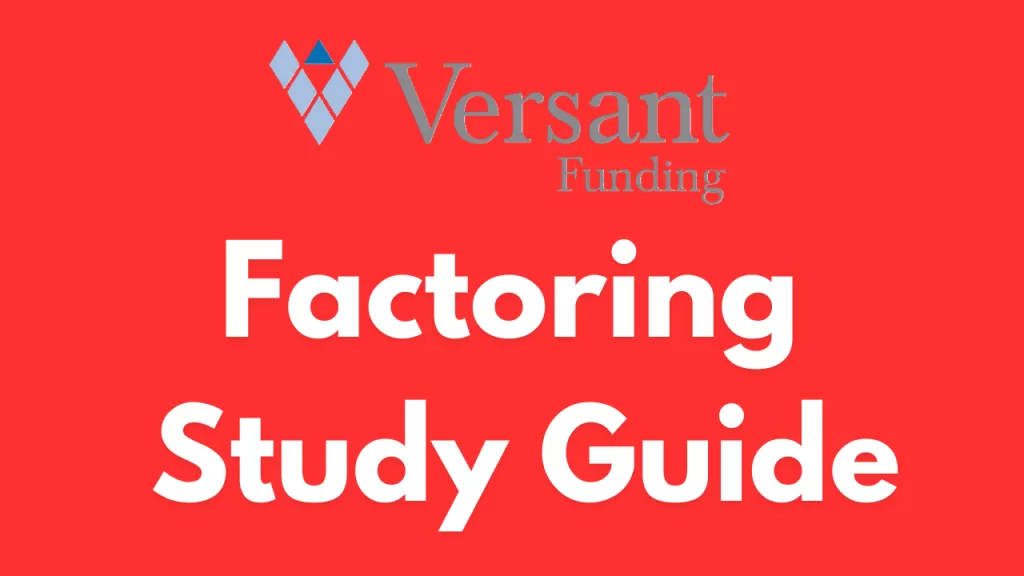Factoring Study Guide – A Primer

Quiz
Instructions: Answer the following questions in 2-3 sentences each.
- What is the core function of factoring, and how does it provide working capital for businesses?
- Describe the difference between recourse and non-recourse factoring, and what impact does it have on risk for the client and the factor?
- How do notification and non-notification factoring differ, and which method is more commonly associated with businesses in weaker financial condition?
- What are some common reasons a business might choose to use a factoring facility?
- What is Versant’s typical advance rate, and what happens with the remaining percentage of the invoice when it’s paid?
- What is Versant’s typical factoring fee structure?
- What are the key differences in Versant’s approach compared to other factoring companies?
- What types of businesses are a good fit for factoring with Versant Funding?
- What are the steps Versant takes when underwriting a potential new client?
- What are two industries Versant does not typically factor?
Factoring Study Guide – A Primer
Answer Key
- Factoring is the sale of a company’s accounts receivable to a third party (the factor) in order to obtain immediate working capital. This provides businesses with cash flow by turning their invoices into cash, rather than waiting for customer payments.
- In recourse factoring, the client is responsible for repaying the advance if their customer does not pay. In non-recourse factoring, the factor assumes the credit risk of non-payment. Non-recourse factoring generally allows businesses in weaker financial situations to be accommodated.
- Notification factoring means the client’s customers are notified to pay the factor directly, often with instructions on the invoice. Non-notification factoring allows payments to be made to the client through a lockbox controlled by the factor. Notification factoring is generally better suited for businesses in weaker financial condition.
- Businesses might use factoring for project financing, business growth, acquisition financing, bridge financing, meeting working capital needs, taking advantage of supplier discounts, navigating a crisis, or as debtor-in-possession financing.
- Versant typically advances up to 75% of the face value of approved receivables. The remaining 25% of the invoice, minus fees, is paid to the client when the receivable is collected.
- Versant’s fee is typically 2.5% of the invoice amount for each month (or portion thereof) the receivable is outstanding.
- Versant focuses on larger and more complex deals, provides fast service (funding within a week), and assigns an Account Executive to each client. They focus more on the credit quality of the client’s customers, and less on the overall financial strength of the business itself.
- Versant is suitable for small to medium-sized businesses with $1-$50 million in annual revenue that need liquidity and may not qualify for traditional bank financing, particularly those with strong customers, even with a weak financial history.
- Versant reviews client’s accounts receivable aging, performs a public records search for UCC filings and liens, conducts a credit review of client’s customers, and verifies receivables by calling customers directly.
- Versant does not typically factor for the medical and construction industries.
Essay Questions
Factoring Study Guide – A Primer
Instructions: Write a well-organized essay for each question. Your essays should demonstrate your understanding of factoring concepts and your ability to connect these concepts to the source materials.
- Discuss the role of factoring as a financing tool for small to medium-sized businesses, comparing and contrasting it with traditional bank financing. Consider factors such as eligibility criteria, speed of funding, and cost.
- Explain the benefits of a non-recourse, full-notification factoring facility for a business that is experiencing financial difficulties and how this model operates from initial referral to final payment of the factored invoices.
- Analyze the competitive landscape of the factoring industry, discussing the differences between smaller and larger factors and Versant’s unique positioning within that landscape.
- Chris Lehnes emphasizes the importance of educating financial intermediaries rather than business owners about factoring. Discuss the reasoning behind this marketing strategy and how it contributes to Versant’s success.
- Assess how Versant’s factoring product and approach has proven beneficial for businesses facing various challenging scenarios (including the impacts of COVID-19) and the impact it has on improving their overall profitability.
